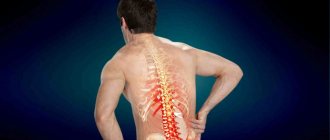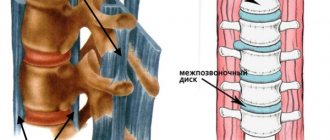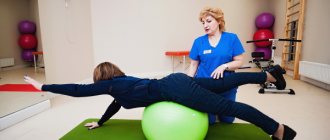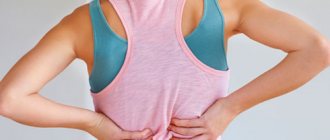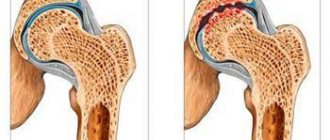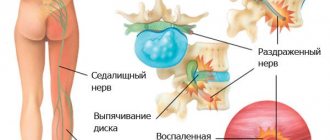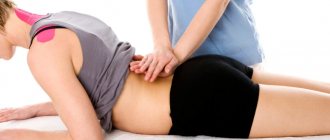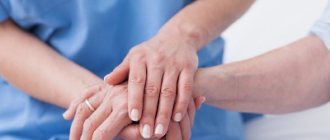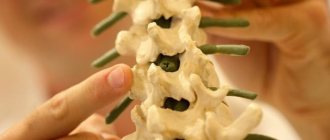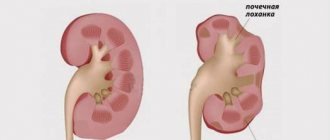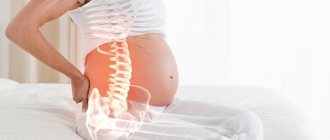Lower back pain is a common symptom in diseases of the spine and some internal organs. Often pain manifestations are observed only during movement and cease to bother when the body is at rest. To determine why the lower back hurts when walking, you should carefully analyze the nature of the pain and the accompanying symptoms, because it is impossible to get rid of the disease without knowing the cause.
Lower back hurts when walking
Causes of lumbar pain
When walking, the lumbar region is subject to greater stress than other parts of the spine. When a person walks, not only muscles and ligaments are involved, but also the vertebrae themselves, intervertebral discs, as well as a complex system of nerve endings. If the tissues are healthy, their interaction does not cause discomfort, regardless of the degree of stress, but the presence of any pathologies changes everything. Changes in the vertebrae and discs lead to pinched roots, the development of inflammatory processes in the muscles, impaired tone and other unpleasant consequences, which cause pain while walking.
The main cause of lower back pain is pathological changes in the spine, accompanied by inflammatory processes and compression of the roots.
Diseases of internal organs can also manifest themselves in a similar way due to vibrations when walking. Every step affects the pelvic area and lower back, but healthy people do not notice this. In the presence of inflammation, swelling or other internal lesions, even a slight impact will result in pain in the lower back, spreading into the peritoneum or higher up the back. And the sharper the step, the stronger the pain is felt. Most often, pain syndrome occurs due to various types of injuries: falling, back bruises, lifting heavy objects, or sudden jerks and turns of the body. Such injuries are usually accompanied by sprain or rupture of ligaments and muscle fibers, which subsequently leads to inflammatory processes in the paravertebral tissues. In more severe cases, the injury can result in displacement of the vertebrae, which also causes severe lower back pain.
Displacement of the vertebrae caused by injury or heavy lifting leads to pinching of nerve fibers and blood vessels in the spinal canal
If you want to learn in more detail how to treat misalignment of the lumbar vertebrae, as well as consider symptoms, alternative treatment methods and preventive measures, you can read an article about this on our portal.
Other common causes of pain when walking include:
- diseases of the spine - osteochondrosis, hernias and protrusions in the lumbar region, spondyloarthrosis, spinal stenosis, radiculitis, sciatica;
- muscle strain due to physical activity - work associated with carrying and lifting weights, prolonged standing, intense sports training;
- muscle inflammation caused by hypothermia or infection in the body;
- kidney diseases.
Painful sensations in the lower back when walking can occur due to inflammation of the kidneys
Important! Pain syndrome can also occur against the background of the development of cancer and the presence of metastases in the spine itself. This is due to the growth of tumors that block the spinal canal and compress the blood vessels and nerve endings located in it. Less commonly, the cause of pain is spinal infections and congenital pathologies of the spine.
Danger of pain
If pain occurs after an injury, then consultation with a specialist is necessary. Since trauma can lead to a fracture of the spine, the appearance of cracks, and displacement of the vertebrae.
In addition, such consequences are accompanied by severe pain and can have detrimental consequences, including immobilization. If the disease is not treated, it can lead to:
- Increased pain.
- Decreased sensitivity of the limbs.
- Decreased mobility.
- The occurrence of various complications.
- Brain diseases, paralysis.
For back and lower back pain, it is important to rule out serious illnesses. Tests will show the presence or absence of an inflammatory process, increased calcium levels, etc.
What do the symptoms indicate?
The probable cause of the illness can be determined by the nature of the pain and the symptoms that accompany it. Of course, it is impossible to make an accurate diagnosis in this way, because many diseases have similar symptoms, but this will help to at least understand the problem a little and find out which specialist to contact.
Table. Main causes of lower back pain
| Causes | Symptoms |
| Intervertebral hernia | First, discomfort and heaviness are felt in the lumbar region when walking, which are then replaced by attacks of sharp pain. The intensity of pain increases when running, jumping, lifting weights and bending the body. Additionally, there is a violation of sensitivity in the sacrum, lower back, legs, stiffness of movements, muscle weakness. If nothing is done, painful attacks begin to occur at the slightest movement and cause severe suffering to the patient. |
| Osteochondrosis | It manifests itself as aching pain while walking and lifting weights. As the pathology progresses, the pain becomes more intense, radiating from the lower back to the buttock and leg, and is felt not only when walking, but also when changing position, coughing, sneezing. After rest, there is severe stiffness in the back, muscle weakness, and possible tingling in the legs. |
| Radiculitis | The pain occurs suddenly, can cover the entire lower back or be felt only on one side, and often radiates to the leg or buttock. Seizures occur when walking, bending, turning, and any careless movements that impact the affected nerve. The pain intensifies when you try to tilt your head forward and palpate the affected area. If the patient tries to get up from a lying position, reflex flexion of the limb is observed. |
| Myositis (muscle inflammation) | At first, there is mild discomfort in the lower back and a feeling of aching. When walking, every step gives off aching pain in the back, which intensifies when bending over, feeling the lumbar region, or hypothermia of the body. Then the pain intensifies and does not go away even at rest, and at the site of muscle inflammation there is redness, swelling, and a local increase in temperature. |
| Kidney diseases | It hurts mainly on one side of the lower back, the pain is dull, and is most strongly felt when running and jumping. As the disease progresses, the intensity of the symptoms increases, problems with urination, cloudiness or darkening of urine may occur, and pain occurs with any movement. |
| Vertebral displacement | A sharp pain occurs in the lower back, then a feeling of numbness appears in the legs, tingling, and a crunching sound is heard in the back when moving the body. There may be a burning sensation in the area of the sacrum or buttock, and limited mobility. |
Important! If, apart from pain, no additional symptoms are observed, this is not a reason to ignore the problem. Even mild pain does not arise just like that, so its cause should be identified and eliminated as early as possible.
Lower back and legs hurt when walking
A set of symptoms in which the lower back and legs hurt when walking, in 90% of cases relates to orthopedic diseases. The source of pain can be located in several places:
- the lumbosacral spine, from where it spreads along the pinched sciatic nerves;
- in the area of the iliac sacral joint of bones with irradiation simultaneously to the sacrum and lower extremities;
- in the area of the gluteal muscles, where the sciatic nerve is pinched and it spreads pain in them along the innervation of the legs and up to the lumbar region, where it originates;
- in the coccyx area, where the so-called “cauda equina” is located - a nerve plexus responsible for the innervation of the internal organs of the abdominal cavity and small pelvis, and lower extremities;
- in the area of the hip joints - when they are destroyed and deformed, all surrounding tissues are damaged and inflamed, the pain is localized on the side and spreads to the lumbar region.
If the lower back hurts greatly when walking and the discomfort spreads to the lower extremities, this means that the situation is not entirely favorable. There was a disruption in the innervation process. If the compression of the nerve fiber is not eliminated and the inflammatory reaction process is not stopped, then other neurological syndromes may appear in the near future. This may include numbness, paresis, muscle fiber dystrophy, changes in gait, paresthesia and paralysis.
Diagnostics
If you have spinal problems, you need to make an appointment with an orthopedic doctor or vertebrologist. If there is nerve pinching, you will definitely need to consult a neurologist. If the symptoms are mixed, and it is not clear which specialist to contact, you should immediately go to your local physician, who, after an initial examination, will refer you to the right doctor. To make a diagnosis, the patient is prescribed tests and hardware studies. Magnetic resonance imaging is considered the most accurate method, with the help of which it is possible to detect any pathological changes at a very early stage, not only in the spine, but also in the internal organs.
Magnetic resonance imaging will allow you to accurately determine the cause of pain and identify possible complications
If the symptoms clearly indicate a hernia, osteochondrosis or radiculitis, X-ray examination is usually used for diagnosis. X-ray is one of the simplest and most accessible methods; moreover, it takes very little time to take an image, unlike CT, where the patient must remain motionless for quite a long time. To assess the condition of blood vessels and soft tissues, an ultrasound is prescribed, and if an infectious nature of the disease is suspected, laboratory tests of blood and urine are required. Based on the results obtained, the doctor selects the optimal treatment method for the patient.
In diseases of the spine, radiography is most often used for diagnosis.
If you want to know in more detail what an ultrasound scan of the spine shows, and also consider whether preparation is needed, features and advantages, you can read an article about this on our portal.
What accompanying symptoms may accompany pain?
In addition to pain, a person may experience increased sweating and muscle spasms in the lumbar region. The pain can move to the lower extremities, to the buttocks. Such symptoms are characteristic of osteochondrosis. There may be lameness and weakness in the legs .
When a hernia occurs, numbness appears in the chest and lower back ; when nerve endings are pinched, the patient complains of pressing pain in the area of the heart .
With radiculitis, the pain is sudden and intensifies when raising the leg. The skin of the face may take on a pale tint .
Muscle spasm during palpation leads to increased pain.
Ways to treat lower back pain
If the pain is caused by pathologies of the internal organs, little depends on the patient: treatment is carried out strictly according to medical prescriptions and is usually based on taking medications and following a special diet. As for diseases of the spine, which for the most part are the cause of back pain when walking, an integrated approach is required here, and the success of treatment largely depends on the patient himself.
Table. Methods for treating lumbar pain
| Type of treatment | Description |
| Drug therapy | It is used at the initial stage to relieve pain, eliminate swelling and inflammation. For acute pain, blockades with novocaine are prescribed; for moderate pain, drugs from the NSAID group (Ibuprofen, Diclofenac, Voltaren and others) are prescribed. For muscle spasms, muscle relaxants (Mydocalm, Tizanidine) are prescribed. Additionally, the patient is prescribed a course of medications with vitamin B and a course of chondroprotectors to restore cartilage tissue. |
| Physiotherapy | It is used as the main method of treatment for spinal pathologies. Exercises are selected by the attending physician taking into account the patient’s condition, the type and severity of the disease, and the presence of complications. Exercises should be performed regularly, 20-30 minutes a day, in accordance with medical recommendations. |
| Massotherapy | A course of massage allows you to eliminate pain, normalize blood circulation and lymph outflow, and even out muscle tone. It is usually prescribed in addition to therapeutic exercises and is carried out in courses of 15-20 sessions approximately 2 times a year. |
| Physiotherapy | Treatment is carried out using electrical impulses, ultrasound, thermal applications and other types of influence on the diseased area. The choice of procedures depends on the type of disease and the degree of damage to the spine, as well as the presence of contraindications for the patient. |
| Swimming pool exercises are one of the most effective ways to treat back problems. In water, the load on the spine is reduced, while muscles and ligaments are actively involved, which helps to effectively strengthen them. Swimming is recommended at any age and has almost no contraindications. |
| Wearing a corset | It is used strictly according to indications when fixation of the spine is necessary. Not suitable for long-term use as it causes atrophy of the back muscles. Corseting serves only as an auxiliary method, and therefore should be combined with physical therapy and massage. |
Surgical treatment is used only as a last resort - if conservative therapy does not help. As a rule, this occurs in the late stages of osteochondrosis, spondylitis, scoliosis and other diseases of a degenerative-dystrophic nature.
What to do if your lower back hurts when walking
The first thing you should do if your lower back hurts when walking is to completely eliminate physical activity. If the cause of the negative symptom is an intervertebral hernia, then continued physical activity can lead to its sequestration (separation). If such a foreign body enters the spinal canal, emergency surgery is required.
The second important step is contacting a specialist. A vertebrologist treats diseases of the spinal column. We recommend contacting specialized manual therapy clinics. They have special equipment that allows the procedure of traction traction of the spinal column. After the second procedure, patients are completely free of pain.
Treatment of diseases of the spinal column and other parts of the musculoskeletal system can currently be carried out exclusively using manual therapy methods. Therapeutic gymnastics and kinesiotherapy in combination with therapeutic massage strengthen the muscular frame of the back and enhance the diffuse nutrition of the cartilage tissue of the intervertebral discs. Osteopathy and reflexology activate the processes of microcirculation of blood and lymphatic fluid, starting the process of regeneration of damaged tissues. Laser therapy, physiotherapy and other methods of treatment are also used.
If you need a consultation with a vertebrologist in Moscow, you can get it completely free of charge in our manual therapy clinic. Call the administrator and make an appointment.
Walking as therapy
Back pain that occurs when walking forces many to limit their movements and spend more time sitting or lying down. Meanwhile, proper walking is also one of the types of therapy for pathologies of the musculoskeletal system.
Proper walking has a beneficial effect on the condition of the spine and is a good prevention of osteochondrosis
In order for it to give only positive results, several rules must be followed.
- Walking is indicated in the absence of serious damage to the skeleton and muscle tissue, otherwise it can only cause harm. Regular walking is very useful in the stage of complete or partial remission of diseases, the main thing is to first consult with your doctor.
- For walking, you need to choose comfortable shoes and clothes that do not restrict movement. It is also worth taking into account the weather conditions so that you do not have to sweat or, conversely, shake from the cold while walking.
For walking you need to choose comfortable clothes and shoes - If the patient led a sedentary lifestyle, the duration of walking for recovery should be increased gradually, starting with walks of 15-20 minutes a day. It is very important not to overdo it so as not to put undue stress on the lower back. After walking, you should feel pleasantly tired, not acute pain or discomfort.
- You need to walk at a pace that is comfortable for you so that you don’t lose your breath. Shoulders should be straightened, stomach pulled in, back straight. If this position is difficult to maintain, you can lean on a stick.
- Hiking must be combined with therapeutic exercises, and before walking it is recommended to do a short warm-up to warm up the muscles.
Nordic walking
Compliance with these simple conditions will help you quickly cope with the disease and strengthen your spine. In addition, walking is also an excellent preventative measure, so regular walks in the fresh air will not be superfluous, even if no problems with the spine are observed.
Video - Lower back hurts when walking
Lower back pain when walking and standing - diagnosis
If your lower back hurts when walking and standing, diagnosis should be carried out by an experienced doctor. You should make an appointment with a vertebrologist or neurologist. The doctor will conduct an initial examination, do a series of functional tests and collect medical history. This information will allow him to make a preliminary diagnosis and develop a plan for subsequent examinations. In our manual therapy clinic, the initial examination of the patient is free of charge. During a free consultation, the patient can receive comprehensive information about what prospects and treatment options exist for the disease identified in him.
Sign up for a free initial consultation with a vertebrologist and you will find out a preliminary diagnosis. Then you will probably need to take x-rays of the lumbosacral spine, hip joint and iliosacral joint bones. In complex diagnostic cases, an MRI examination is prescribed.
Symptoms - clinics in
Choose among the best clinics based on reviews and the best price and make an appointment
Family
Oriental Medicine Clinic "Sagan Dali"
Moscow, prosp.
Mira, 79, building 1 Rizhskaya
+7
- Consultation from 1500
- Diagnostics from 0
- Reflexology from 1000
0 Write your review
Family
Clinic "Diamed Maryina Roshcha"
Moscow, Sheremetyevskaya st., 27, 1st floor
Maryina Roshcha
8
- Consultation from 1600
- Shock wave therapy from 1200
- Reflexology from 2200
9 Write your review
Family
Medical Center for Immunocorrection named after. R.N. Khodanova
Moscow, st.
Davydkovskaya, 6 Slavyansky Boulevard
+7(499)445-40-83
- Reception from 1500
- Diagnostics from 200
- Hirudotherapy from 1150
10 Write your review
Show all Moscow clinics
Symptoms - specialists in Moscow
Choose among the best specialists based on reviews and the best price and make an appointment with
Therapist
Batomunkuev Alexander Sergeevich
Moscow, prosp. Mira, 79, building 1 (Oriental Medicine Clinic “Sagan Dali”)
+7
0 Write your review
RheumatologistTherapist
Perelygina Elena Viktorovna
Moscow, Landyshevaya st., 14, bldg. 1 (Medical)
+7
0 Write your review
Therapist
